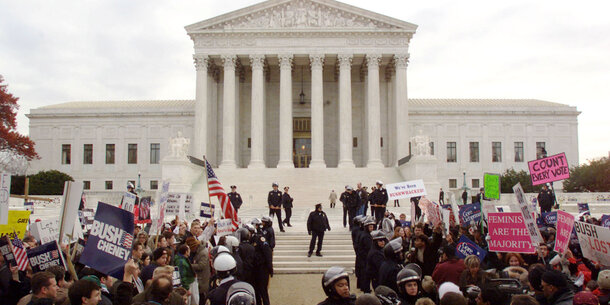In his new book, The Supermajority, publishing in June, Brennan Center President and CEO Michael Waldman recounts the earthshaking 2022 Supreme Court term, comparing it with previous eras of high court activism.
The Supreme Court has long been conservative. Why did you decide to write this book now?
The conservative legal movement has been building toward this moment for decades: a new 6–3 conservative supermajority. The numbers matter. A single swing justice will no longer pull the Supreme Court toward a more moderate approach. We saw the results clearly: three decades of social change — on abortion, guns, and environmental regulation — crammed into three days in June 2022. This is a big moment for the country. It’s a big moment for the Brennan Center too, as we assess our own future work and strategy.
The book begins with a history of the Supreme Court, focusing on major inflection points — Marbury v. Madison, Dred Scott, the Lochner era, and the Warren Court. Why are these critical to understanding the current Court?
The U.S. Supreme Court is a singular institution. In no other democracy do nine unelected officials have so much power.
Over the country’s history, the Supreme Court has largely aligned with the country’s political consensus. But on a few occasions, it has been extreme, partisan, or very activist. When that happens, there is a massive backlash and sometimes even a political realignment. Dred Scott, which legalized slavery throughout the country, propelled the rise of the Republican Party and helped ignite the Civil War. In the Lochner era, the Court responded to social and economic upheaval by blocking progressive government regulation. It led to decades of backlash, including Theodore Roosevelt’s 1912 third-party run for president, and of course the conflict between his cousin Franklin and the “Nine Old Men.” We are living through the backlash against the Warren Court to this very day. There is a regular cycle of Supreme Court overreach and backlash. So it’s entirely appropriate for Americans to debate the Supreme Court in explicitly political terms, as we have all through our history.
The Warren Court was an outlier — activist Supreme Courts are usually regressive — and it’s important for progressives to shed their illusions.
You write that Chief Justice John Roberts is canny about protecting the Court’s legitimacy, except when it comes to one issue.
On the law of democracy, Roberts has moved the Court rightward with the activist enthusiasm of a starched-collar justice in the Lochner era. The eviscerating of the Voting Rights Act in Shelby County. The refusal to police partisan gerrymandering in Rucho. The convulsive changes to our campaign finance system in Citizens United. All of them created the deeply unfair political system we have right now.
Roberts often said, “If it is not necessary to decide more to dispose of a case, then it is necessary not to decide more.” But Roberts’s record on democracy issues hardly reflects that philosophy of judicial minimalism.
You describe this past Court term as radical.
These were landmark decisions. The Dobbs ruling on abortion overturned a fundamental right for the first time in the country’s history, a protection for women over a half century. It puts at risk all other privacy rights as well. Bruen ruled that gun safety laws were unconstitutional unless they followed “history and tradition,” meaning literally that any modern gun regulation must have a direct analog in the colonial era. Public safety concerns play no role. Hundreds of gun laws are now at risk. West Virginia v. EPA blocked a major climate change regulation and articulated a new “major questions” rule — if a topic is urgent and big enough, a regulatory agency is barred from acting, even if basic laws passed by Congress authorize action. It is the first major rollback of the regulatory state in decades.
This Court is formally the Roberts Court, but you say it is ideologically the Thomas Court. In what way do the Court’s recent opinions reflect the jurisprudence of Justice Clarence Thomas?
Thomas has long argued that stare decisis, respect for precedent, is just “a mantra when we don’t want to think.” He does his own analysis of original intent and ignores everything that has happened since then. This jurisprudence used to be on the Court’s fringe. Antonin Scalia was asked what the difference was between himself and Thomas. He answered, “I’m an originalist and a textualist, not a nut.” Now Thomas is the senior justice among the most conservative members, assigning opinions when Roberts is not in the majority. His extreme brand of originalism has become dominant.
Is there a way to stop the originalist movement, other than via a major change in the Court’s composition?
The Supreme Court did not rely on originalism through most of its history. The past was important, but the justices focused on what the country needed and how it had evolved. The rise of originalism as the dominant approach really only happened in this past year.
There are only four major originalist decisions. The first, Dred Scott, was so notorious that it discredited originalism for a long time. Heller in 2008, establishing a Second Amendment right to private gun ownership. Dobbs and Bruen last year. That’s it! There is no history and tradition of relying only on history and tradition to make constitutional decisions.
But you can’t beat something with nothing. Unfortunately, opponents of originalism have fallen silent. It’s painful to watch confirmation hearings in which even progressive judicial nominees pledge to follow regressive originalist dogma. We need to articulate a vision for an enduring Constitution that is adaptable to a changing country, one that looks forward, not backward.
You can order The Supermajority here.



